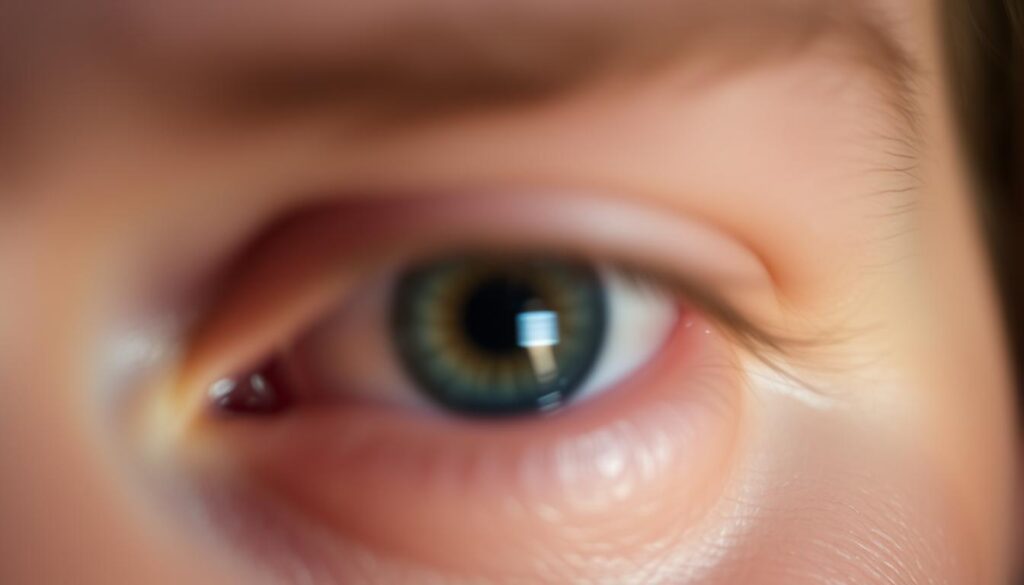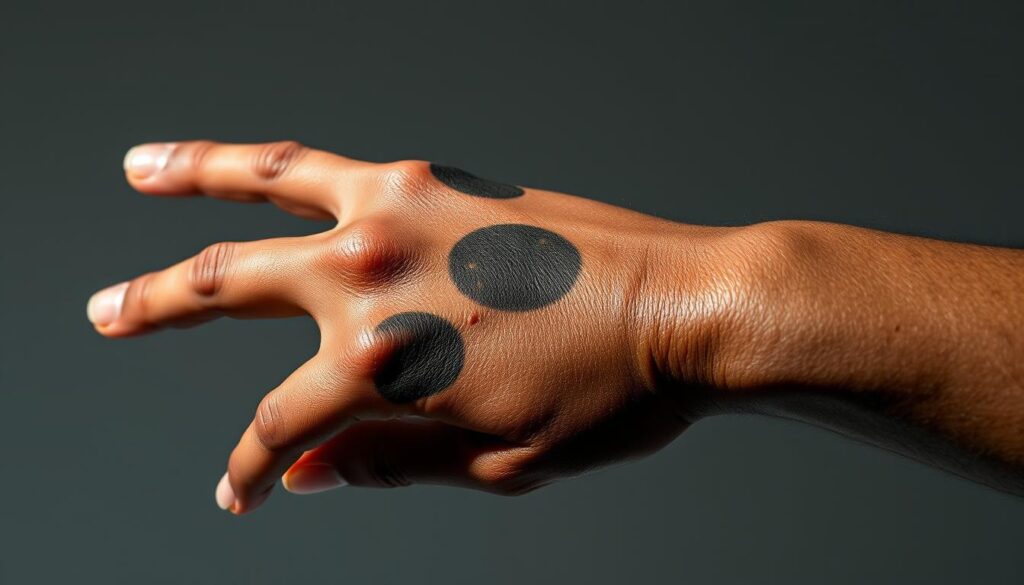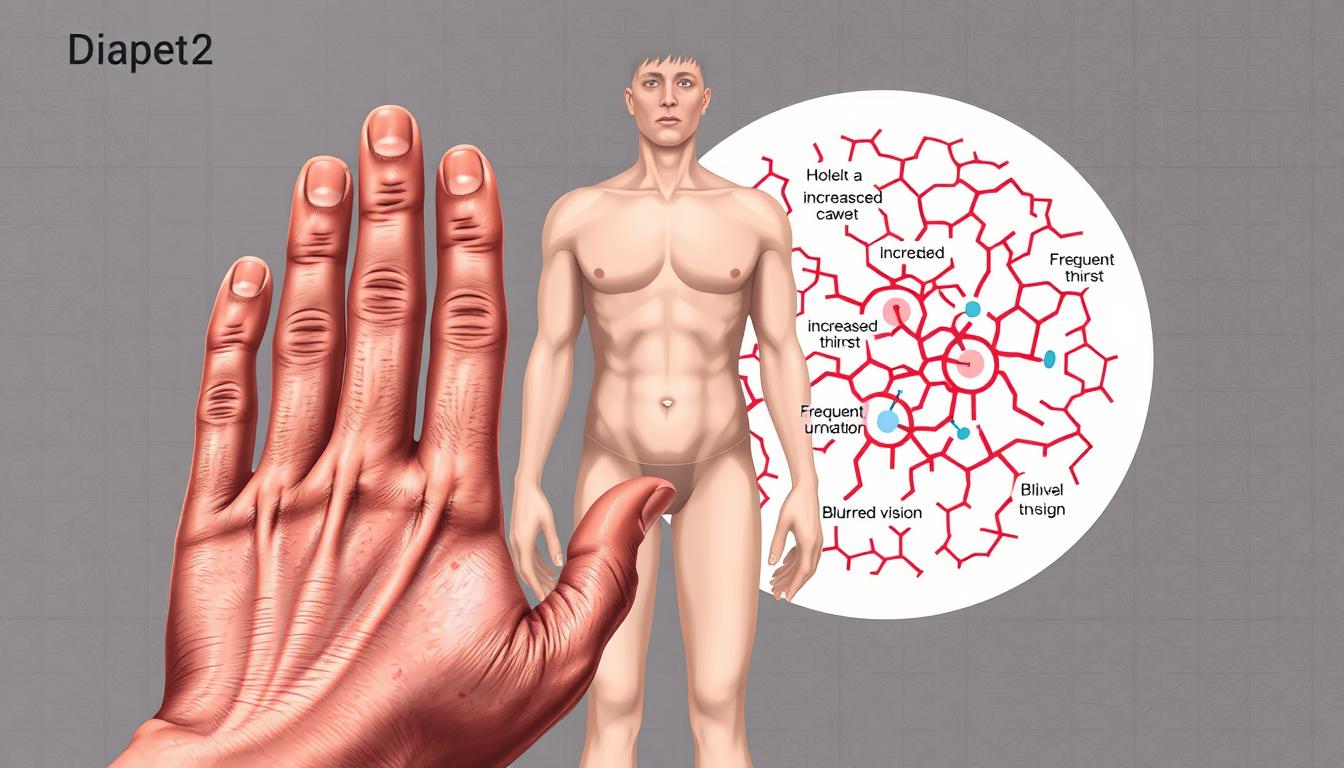Do you know the warning signs of type 2 diabetes? Many people find out they have it years after it starts. I want to share with you the important signs that might mean you’re getting type 2 diabetes.
Finding out early is key. It lets you change your lifestyle and get medical help right away. Knowing the early signs of diabetes is the first step to managing it well. We’ll look at the 9 key symptoms to watch for. This will help you stay healthy.
What Is Type2 Diabetes?
Type 2 diabetes affects how the body uses insulin. It’s a long-term condition where the body can’t use insulin well. This leads to high blood sugar levels.
Insulin Resistance: A Key Factor
Insulin resistance makes it hard for glucose to get into cells. The pancreas then makes more insulin. But it can’t keep up, causing high blood sugar.
Factors contributing to insulin resistance include:
- Genetics
- Obesity
- Physical inactivity
- A diet high in sugars and saturated fats
The Distinction Between Type 1 and Type 2 Diabetes
Type 1 diabetes is when the immune system attacks insulin-making cells. This results in no insulin production. Type 2 diabetes is about insulin resistance, where the body still makes insulin but can’t use it well.
Knowing the difference is key for the right treatment.
9 Type2 Diabetes Symptoms To Watch For
It’s important to know the signs of type 2 diabetes early. This helps you manage it better and avoid serious problems. Type 2 diabetes often starts slowly, so knowing the early signs is key.
Why Early Detection Matters
Finding type 2 diabetes early is crucial. It lets you start treatments that can greatly improve your health. Early treatment can stop serious problems like heart disease and vision loss.
Timely intervention also lowers the risk of other health issues. This improves your life quality a lot.
How Symptoms May Vary in Severity
Symptoms of type 2 diabetes can be different for everyone. Some people might have many symptoms, while others have just a few. The severity of symptoms can also vary a lot.
Understanding this variability helps spot the condition early. Common symptoms include needing to pee a lot, feeling very thirsty, and being tired. You might also see blurred vision, slow healing of cuts, and numbness in your hands or feet.
A type 2 diabetes symptoms checklist can help you keep an eye on your health. It’s also good to remember that some symptoms might be more common in certain groups, like signs of diabetes in men or diabetic symptoms in women. This shows why getting advice from your doctor is so important.
Frequent Urination and Increased Thirst
High blood sugar can start a cycle of needing to pee a lot and feeling very thirsty. This happens because the body tries to get rid of extra sugar by making more urine. This can lead to dehydration.
The Science Behind Polyuria and Polydipsia
When blood sugar goes up, the kidneys have to work hard to filter out the extra sugar. If they can’t keep up, sugar ends up in the urine. This takes water with it, causing polyuria (frequent urination). This then leads to dehydration, making you feel polydipsia (thirsty).
Tracking Changes in Your Bathroom Habits
Watching how often you go to the bathroom can tell you a lot about your health. If you find yourself going more often, or even at night, it might mean your blood sugar is off. Look out for these signs:
- Increased frequency of urination
- Urinating larger amounts than usual
- Feeling thirsty even after drinking plenty of water
Noticing these changes can help you catch problems early. This way, you can take action sooner.
Unexplained Weight Loss Despite Normal Eating
Unexplained weight loss might mean your body is trying to tell you something. If you have Type 2 Diabetes, your body might not use insulin well. This can lead to high blood sugar levels.
When Weight Loss Is a Warning Sign
When you lose weight without trying, it’s a sign your body isn’t getting enough glucose. So, it starts breaking down fat and muscle for energy. This is a common sign of Type 2 Diabetes.
How Diabetes Affects Your Metabolism
Type 2 Diabetes really messes with your metabolism. Insulin is supposed to help glucose get into your cells. But if you’re insulin resistant, glucose can’t get in easily. This causes high blood sugar levels.
Your body then starts breaking down fat and muscle for energy. This results in weight loss.
| Metabolic Change | Effect on the Body |
|---|---|
| Insulin Resistance | Glucose can’t enter cells efficiently |
| High Blood Sugar | Glucose accumulates in the bloodstream |
| Breakdown of Fat and Muscle | Weight loss due to lack of glucose in cells |
It’s important to understand how Type 2 Diabetes affects your metabolism. Recognizing signs like unexplained weight loss can help you get medical help early.
Persistent Hunger and Unusual Fatigue
Type 2 Diabetes often shows up as persistent hunger and unusual fatigue. These symptoms can really mess with your daily life. They’re closely tied to how your body handles blood sugar and energy.
With Type 2 Diabetes, your cells don’t respond well to insulin. Insulin is a hormone that helps control blood sugar levels. So, glucose can’t get into your cells, causing insulin resistance.
This resistance means your cells are always hungry for energy, even after you eat.
Why Your Cells Are Starving Despite Eating
Feeling hungry all the time, or polyphagia, happens because your body can’t use glucose right. Even after eating, your cells still need energy. This makes you feel hungry again, starting a cycle of constant hunger.
The Connection Between Blood Sugar and Energy Levels
Fatigue is a common symptom of Type 2 Diabetes too. When your cells can’t use glucose, your energy drops. Glucose is key for your cells’ energy, and without it, you feel tired and weak.
Understanding how blood sugar energy affects symptoms like hunger and fatigue is key. By managing blood sugar, people with Type 2 Diabetes can reduce these symptoms and improve their health.
Blurred Vision and Eye Problems
Blurred vision is a common symptom of type2 diabetes. It can signal a bigger problem. High blood sugar makes the lens in the eye swell, causing blurry vision. This happens because too much glucose in the blood messes with how the lens focuses light.

Damage to the Eyes
Diabetes can harm the blood vessels in the retina. This can lead to diabetic retinopathy and vision loss. When these blood vessels get damaged, they might leak or get blocked. This makes it hard for the retina to work right.
Reversible vs. Permanent Changes
Some vision changes from diabetes can be fixed, but others can’t. If not treated, diabetic retinopathy can cause permanent vision loss. But, keeping blood sugar levels in check and getting medical help early can help some vision problems get better.
Knowing about eye problems linked to diabetes is key. Protecting your vision is crucial. Regular eye exams can catch issues early. And, managing your blood sugar can lower the risk of serious eye problems.
Slow-Healing Wounds and Frequent Infections
Many people with type 2 diabetes face slow-healing wounds and frequent infections. High blood sugar harms blood flow and weakens the immune system. This makes it tough for wounds to heal and raises the chance of getting infections.
The Impact on Wound Healing
Diabetes can make it hard for your body to heal wounds. High blood sugar damages blood vessels and nerves. This reduces blood flow and the delivery of oxygen and nutrients to wounds.
As a result, cuts and bruises take longer to heal. This increases the risk of getting an infection.
Common Infections in Diabetes
Diabetes makes you more likely to get infections. This includes skin, urinary tract, and yeast infections. These infections can be more serious and harder to treat because of a weakened immune system.
| Infection Type | Common Symptoms | Prevention Tips |
|---|---|---|
| Skin Infections | Redness, swelling, warmth, and pus | Keep skin clean and dry, use antibacterial soap |
| Urinary Tract Infections | Burning sensation while urinating, frequent urination | Drink plenty of water, urinate when needed |
| Yeast Infections | Itching, redness, and discharge | Maintain good hygiene, wear breathable clothing |
Managing your blood sugar is key to avoiding slow-healing wounds and infections. Keeping your blood sugar in check helps your body heal better. It also lowers the risk of getting infections.
Tingling or Numbness in Extremities
Tingling or numbness in the hands and feet can signal diabetic neuropathy, a type 2 diabetes complication. High blood sugar can harm nerves, causing tingling or numbness, mainly in the feet.
Early Signs of Diabetic Neuropathy
Diabetic neuropathy happens when high blood sugar damages nerves. Early signs include:
- Tingling or numbness in the hands and feet
- Pain or burning sensations
- Muscle weakness
- Sensitivity to touch
Spotting these symptoms early is key to managing diabetic neuropathy and avoiding more nerve damage.
Protecting Your Feet When You Have Diabetes
Foot care is vital for people with diabetes to avoid complications. Here are some tips:
- Check your feet daily for cuts, blisters, or swelling.
- Keep your feet clean and dry.
- Wear comfortable, well-fitting shoes.
- Avoid walking barefoot.
By following these steps, you can lower the chance of serious foot issues linked to diabetic neuropathy.
Dark Patches of Skin (Acanthosis Nigricans)
Acanthosis nigricans is a condition where dark, velvety skin patches appear. It’s linked to insulin resistance, a sign of type 2 diabetes. These patches often show up in body folds and creases.

Recognizing This Pre-Diabetes Warning Sign
Spotting acanthosis nigricans early is key. It shows as dark skin patches that feel velvety. These patches are more than just a skin issue; they signal pre-diabetes and need attention.
Common Locations and Appearance
Acanthosis nigricans usually pops up in body folds. You might see it in the neck, armpits, elbows, knees, and knuckles. The patches can range from light brown to dark black. They might also make the skin thicker.
Knowing about these dark skin patches is important. They can help spot pre-diabetes and type 2 diabetes early. If you see these changes, see a doctor right away.
Gender-Specific Diabetes Symptoms
It’s important to know the specific symptoms of diabetes for men and women. These symptoms can vary due to hormonal differences.
Unique Signs of Diabetes in Men
Men with diabetes might notice certain symptoms more often. These include erectile dysfunction and lower sex drive. Knowing these signs helps men get the right medical help.
How Diabetes Symptoms May Present in Women
Women with diabetes often face urinary and vaginal infections. They might also see changes in their menstrual cycle. These symptoms can be linked to premenstrual syndrome (PMS).
Hormonal Influences on Diabetes Symptoms
Hormonal changes affect how diabetes symptoms show up in both men and women. For women, changes in estrogen levels can impact blood sugar. In men, testosterone levels play a role in symptoms and health.
| Symptom | Men | Women |
|---|---|---|
| Sexual Health Issues | Erectile Dysfunction | Vaginal Infections |
| Infection Risks | Urinary Tract Infections | Yeast Infections, UTIs |
| Hormonal Influences | Testosterone Levels | Estrogen Fluctuations |
Knowing the gender-specific diabetes symptoms is key to managing the disease. Recognizing these unique signs helps both men and women get the right care and manage their condition effectively.
When to See a Doctor and What to Expect
If you think you might have type2 diabetes, getting ready for your doctor’s visit is key. Knowing the signs is important. But knowing what happens next can make you feel better and help your health.
Warning Signs That Require Immediate Medical Attention
Some symptoms need you to see a doctor right away. These include really thirsty and needing to pee a lot, losing weight without trying, blurry vision, and slow-healing cuts or wounds. If you have any of these, go to the doctor fast.
| Symptom | Description |
|---|---|
| Severe Thirst | Feeling extremely thirsty, even after drinking plenty of water |
| Frequent Urination | Needing to urinate more often than usual |
| Unexplained Weight Loss | Losing weight without changing your diet or exercise routine |
Common Tests for Diagnosing Type2 Diabetes
Tests like theFasting Plasma Glucose (FPG) testand theOral Glucose Tolerance Test (OGTT)are used to find type2 diabetes. The FPG test checks your blood sugar after not eating for a while. The OGTT tests how well your body handles sugar after drinking a sweet drink.
Preparing for Your Doctor's Appointment
Get ready for your doctor’s visit by making a list of your symptoms and questions. Also, bring any medicines you’re taking. Having a friend or family member with you can help. Talking openly about your symptoms and health history helps your doctor help you better.
Understanding what to expect and being ready can help you manage your health. It ensures you get the care you need.
Conclusion
Recognizing type2 diabetes symptoms is the first step to managing your health. It requires lifestyle changes, monitoring, and medical treatment. By understanding symptoms and taking action, you can improve your health and lower the risk of complications.
Living with diabetes means paying attention to your daily habits. This includes your diet and exercise routine to keep blood sugar levels healthy. Regular check-ups with your healthcare provider are also key. Being informed and proactive helps you face diabetes challenges and live a healthy life.
Early detection and effective management of type2 diabetes symptoms prevent long-term damage. Being aware of the signs and acting quickly can greatly improve your quality of life. Managing type2 diabetes is a journey that needs commitment. But with the right approach and support, you can keep your condition under control and stay healthy.
FAQ
What are the common symptoms of type2 diabetes?
Symptoms include frequent urination and increased thirst. You might also lose weight without trying, feel hungry all the time, and tired easily. Blurred vision, slow-healing wounds, and numbness in your hands and feet are also signs. Dark patches on your skin are another symptom.
How does insulin resistance develop?
Insulin resistance happens when your body’s cells don’t respond well to insulin. This makes it hard for glucose to get into the cells. As a result, your blood sugar levels go up.
What is the difference between type1 and type2 diabetes?
Type1 diabetes means your body can’t make insulin. Type2 diabetes is when your body doesn’t use insulin well and doesn’t make enough.
Why is early detection of type2 diabetes important?
Finding type2 diabetes early helps manage it better. It prevents serious problems and improves your health.
Can diabetes symptoms vary between men and women?
Yes, symptoms can differ because of hormones. Some symptoms are more common in one gender than the other.
What are the common tests used for diagnosing type2 diabetes?
Tests include fasting plasma glucose, oral glucose tolerance test, and hemoglobin A1c (HbA1c) test.
How can I prepare for a doctor’s appointment to diagnose type2 diabetes?
Prepare by gathering your medical history and listing your symptoms. Be ready to talk about your lifestyle, diet, and any concerns.
What are the warning signs that require immediate medical attention for type2 diabetes?
Severe symptoms like trouble breathing, chest pain, severe stomach pain, or severe dehydration need immediate help.
How does type2 diabetes affect vision?
High blood sugar can harm the retina’s blood vessels and swell the lens. This can cause blurred vision and permanent vision changes.
What is diabetic neuropathy, and how can it be managed?
Diabetic neuropathy is nerve damage from high blood sugar. It causes tingling or numbness in your extremities. To manage it, control your blood sugar, protect your feet, and consider medication.


